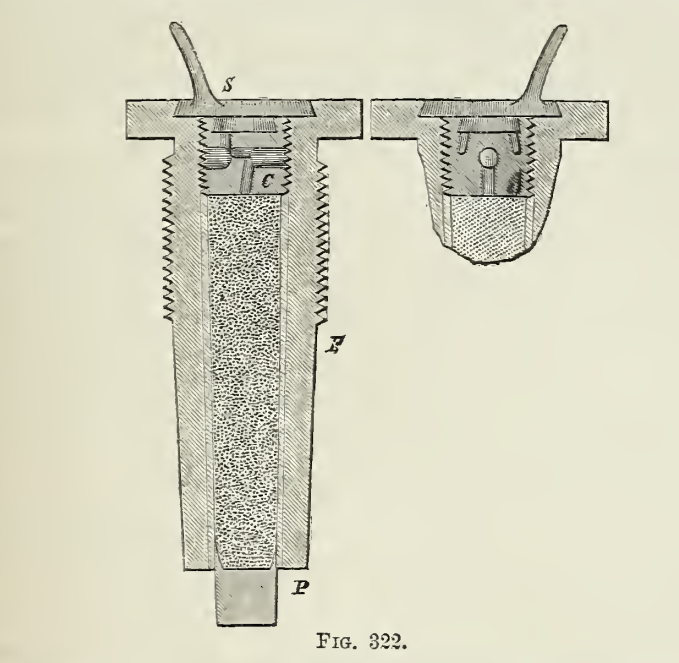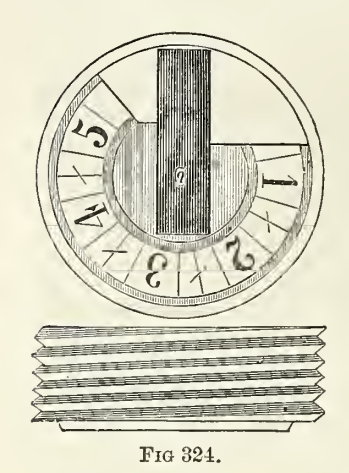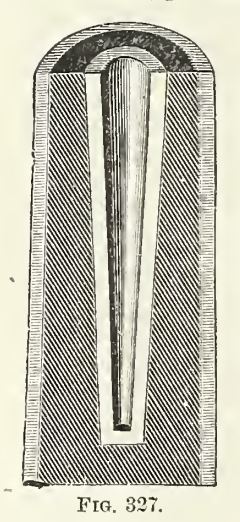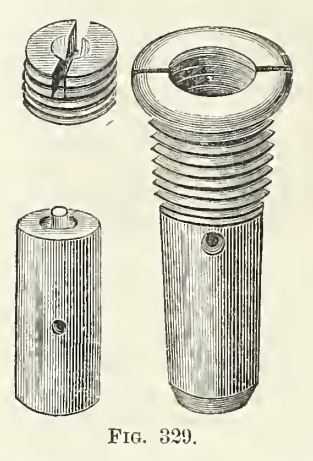One aspect of battleship ammunition that I have not discussed very much (with one notable exception) is fuzing, the process of making shells go off at the appropriate time. But this is a critical part of gunnery, as a shell that doesn't go off is of very little use, while a shell that goes off early is potentially disastrous. Designers have to meet both of these challenges while also keeping the fuze compact and setting it up for best effect against the target.

An early tubular time fuze
The earliest shells used time fuzes, which at their core were tubes of packed gunpowder calibrated to burn for a specific length of time after being ignited by the powder gasses on firing, in the hope that they would go off after the shell was lodged in the target. This posed a number of problems. First, shells that bounced off or broke up on impact would do no damage, and there was even the possibility that a very brave man could douse a shell's fuze or throw it overboard. Second, the packed gunpowder was easily damaged by the force of firing, particularly on the early wooden-cased fuzes, which would tend to expose more surface area and cause the fuze to detonate early. Third, the burning fuze could be snuffed out on impact, a particular problem if it ricocheted off the water before reaching the target. And fourth, while the burning time could be adjusted by cutting the fuze tube, and most fuzes, whether metal or wood-cased, were marked to accommodate this, it was a rather involved process in the heat of battle, particularly because the fuze then had to be inserted into the shell before the gun could be loaded. Cutting fuzes could be eliminated by supplying each shell with a number of different fuzes cut and formulated to burn to different times, but that didn't solve the problems of needing to fit them to the shell in action. And of course the exposed fuzes were vulnerable to mechanical damage or water.

A Bormann Time Fuze
Some of these problems were solved by the 1860s with the introduction of the Bormann time fuze. In this case, the delay element was a three-quarter circle of pressed powder, covered with a thin metal case marked in quarter-second increments. One end of the horseshoe is connected to a charge of fine powder in the center, which is cut off from the interior of the shell by a thin lead plate. Before firing, the outer metal cover is punctured at the mark corresponding to the desired delay, which provides a path for the powder flash to ignite the delay element. The element would burn both ways, and while one side will simply hit the end of the horseshoe and stop, the other would eventually ignite the fine powder, which would serve as a booster, blowing the lead plate out of the way and setting off the main charge. The whole fuze mechanism was sealed from outside moisture before the delay was selected, and proved so robust that in tests, some were fired intact, recovered, then set and fired successfully. This fuze also solved another problem of previous fuzes. In those, the powder was packed a bit at a time, so the powder towards the bottom was packed more densely and the burning rate varied. The Bormann fuze was all packed horizontally, and avoided this problem.

A plaster-cone concussion fuze
But while Captain Bormann had done a great deal to improve the time fuze, it still would have been preferable to simply have the projectile detonate on impact, and a great deal of ingenuity went into the problem of making a fuze that could do so with round shot (which obviously couldn't be counted on to hit in a specific orientation, despite attempts to weight projectiles to do so) at an acceptable level of safety. These were divided into two types: percussive fuzes, which functioned entirely on impact using substances like mercury fulminate, and concussive fuzes, which would be lit by the muzzle flash, but keep the fire separate from the main charge until impact. The risk of a percussive fuze detonating if dropped or fired meant that concussive fuzes made up the majority of attempts. A typical example had a plaster cone embedded in a block of powder, which would support it when the gun was fired. As the shell flew, the powder burned away, and upon impact, the unsupported portion of the cone would break, allowing the flash through. Nor was this the only example, with one particular design using a cast zinc cone packed with powder and taking advantage of the fact that it gets brittle when it gets hot to shatter on impact.

An early percussion fuze, with body (right), striker (bottom left) and safety cap (top left)
But all of this was soon irrelevant, as the development of rifled guns meant that shells could be expected to impact in a consistent orientation, opening the way for percussive fuzes to become ubiquitous. The earliest were quite simple, essentially a plunger with a percussion cap, retained by a pin that would break when the shell was fired. The plunger would then go to the back of the shell, flying forward on impact and setting off the cap. As a second line of defense against accidental detonation, the USN fitted its with a safety cap, with one side flat and one countersunk, that screwed into the end of the fuze. For normal handling, the countersunk side faced the plunger, meaning that the percussion cap wouldn't hit anything even if the plunger happened to break loose. Shortly before firing, it would be unscrewed and flipped over, allowing the percussion cap to detonate on impact.
Rifling had unlocked reliable percussion fuzes, but they were still limited in several ways. First, safety was not all it could be, and the risk of accidental detonation was still far too high. And second, the fuze would set the shell off immediately on impact. This was fine for high-explosive shells, but less effective against armored targets. Both problems would be overcome, a process we will talk about next time.
For those interested in early fuze development (and late 19th-century naval ordnance more generally), see here and here.

Comments
Great read Bean. Fuzes are something that always interested me and not much is out there about them.
Looking forward to the next interation.
Good stuff. I suspect there was an amazing amount of experimentation here... and a lot of things that didn't work in practice.
...Excellent work, sir, and most illuminating! Bomb fuzes, I know - these things not quite so much.